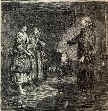

Cult of Domesticity and Women's Rights Movement
The Cult of Domesticity or "Cult of True Womanhood" was a prevailing view during the Jackson Era. It is the belief that a woman's role in marriage is maintaining the home as a refuge for her husband, care for and teach the children setting moral values for children to follow.
True women were expected to possess the virtues of piety, purity,
submissiveness, and domesticity.
It identified the home as the "separate, proper sphere" for
women, who were seen as better suited to parenting.
The "cult" developed as family lost its function as economic unit. Many of the links between family and community closed off as work left home and market economy emerged downgrading a women's work. Men no longer stayed home to earn a living, instead going out into the community in business endeavors.
During the 1830s, Angelina and Sarah Grimke challenged this narrow definition of women's roles through participation in the antislavery movement. They were accused of leaving their proper roles, defying the God's laws, and endangering the family. Most women did not agree with the Grimke sisters. This lead to a questioning and split over the "proper place" of women and the beginning of the nineteenth-century women's rights movement.
1948 marked the emergence of the women's rights movement after the Seneca Falls Convention at which Elizabeth Cady Stanton presented the Declaration of Sentiments containing several resolutions including that a man should not withhold a woman's rights, take her property or refuse to allow her to vote.
In 1866, the American Women’s Suffrage Association was formed. The association was dedicated to universal suffrage for men and women of all races, in part in answer to the antislavery movement.
Women also learned techniques that allowed them to lobby for reform which lead to the Temperance movement.
Home Reform Page